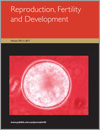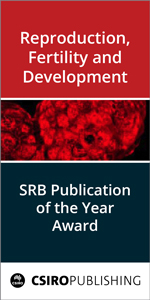Reproduction, Fertility and Development
Volume 29
Number 11 2017
Sex-specific differences have been reported in most of the diseases. This review provides data on differential adaptation of male and female fetuses in utero in response to maternal nutritional, physiological and environmental insults resulting in sex-specific differences. Because sex differences are associated with fetal outcome and survival, it is of importance to study the underlying biological mechanisms to improve both pre-natal and neonatal care.
Knowledge of molecular defects in spermatozoa becomes critical during assisted reproduction to treat male factor infertility. Herein we show that the absence or low expression of protocadherin 11Yb (PCDH11Yb) in spermatozoa is associated with male factor infertility. Profiling of a panel of differentially expressed sperm proteins, including PCDH11Yb, in men with infertility may be of diagnostic and therapeutic value in infertility management.
Decidualisation and vascular remodelling are fundamental for placentation and pregnancy success. Disruption of endogenous lysophosphatidic acid signalling modified the development of uterine vessels with consequences in the formation of the decidua and placenta, compromising the growth of embryos. Defects in these mechanisms could appear as obstetric complications, like implantation failure, positioning lysophosphatidic acid as a regulatory key lipid at implantation.
Limited information is available about the role of growth factors in very early embryonic development. This study demonstrates the presence of stem cell factor, stanniocalcin-1, connective tissue growth factor and heparin-binding epidermal growth factor-like growth factor in bovine uterine fluid, endometrium and embryos during blastocyst formation. The results suggest a role for these proteins in early embryo development in cattle.
Antifreeze glycoprotein 8 (AFGP8) supplementation during vitrification beneficially protects bovine blastocysts against chill-induced injury. AFGP8 supplementation during vitrification enhances the cryosurvival of bovine blastocysts. AFGP8 supplementation during vitrification improves the subsequent in vitro developmental capacity of bovine blastocysts.
uPA shRNA lentivirus system induced by Dox inhibited the expression of uPA in TM4 cells. Through injecting the lentivirus into mice testis, we found that downregulation of uPA in mice testis decreased the fertility of male mice, which may be caused by a reduction in sperm motility. The inducible uPA shRNA system is safe and reversible to regulate male fertility.
Live cell RNA imaging in mammalian embryos would represent a quantum leap in understanding cell differentiation and early embryonic development. Applicability of RNA imaging by SmartFlare technology was tested in equine embryos surrounded by an embryonic capsule and/or the zona pellucida, nude trophoblastic vesicles and fibroblast cell cultures. Encapsulated embryos block SmartFlare uptake, but stages surrounded by the zona pellucida only and nude vesicles incorporate the probes, leading to specific fluorescence suitable for tracing gene expression cascades necessary for further embryo development.
Endo-siRNAs play an important role in mouse oocyte meiosis but the function of endo-siRNAs in other species is unknown. In this study, we found that an endo-siRNA deficiency resulted in oocyte spindle abnormalities and apoptosis, suggesting that endo-siRNAs are indispensible for oocyte maturation in pigs. This study unequivocally demonstrates an essential function for endo-siRNAs in mammals.
This work demonstrates that estradiol through the peripheral nervous system modulates the ovarian physiology, favoring the physiological luteolysis. The objective of this work was to demonstrate whether estradiol in superior mesenteric ganglion modifies the release of ovarian progesterone, estradiol, nitric oxide and noradrenaline on DII day. The ganglionic stimulation produces a decrease in the ovarian release of progesterone and estradiol by an increase of nitric oxide and decrease of noradrenaline.
The addition of 20 mM glutamine to the freezing extender significantly improved post-thaw sperm motility, acrosome integrity, membrane integrity and mitochondrial activity. The exposure of spermatozoa to glutamine enhanced their γ-GCS activity and GSH synthesis, while decreasing ROS accumulation, LPO and DNA damage. Therefore, glutamine protects spermatozoa against ROS-induced cryodamage by enhancing GSH synthesis.
The association between bovine endometrial growth and prostaglandin (PG) F2α–PGF2α receptor (PTGFR) signalling activation is unknown. In the present study, cell proliferation and the expression of growth factors essential for endometrial growth were upregulated by PGF2α-PTGFR signalling activation by fluprostenol in bovine endometrial explants in vitro. These results indicate that PGF2α-PTGFR signalling activation could be involved in endometrial growth.
The aim of this study was to develop a new genome preservation technique for goose species. According to our results, goose primordial germ cells (PGCs) migrate between 69 and 84 h of development. The goose blastoderm contains PGCs and by isolating and injecting these blastodermal cells we were able to generate chimeras. Altogether, this method could contribute to the cryopreservation of this species.
This study provides evidence that natriuretic peptide C and steroids interact to slow oocyte nuclear maturation and to enhance oocyte-cumulus communication in cattle. Moreover, it indicates that exposure of the cumulus–oocyte complex to physiological concentrations of these hormones is beneficial to oocyte developmental competence. Therefore, the dataset is of relevance for the progress of oocyte biology and for the improvement of in vitro maturation outcomes.
This paper describes findings during a unique opportunity to monitor placental structure and function throughout pregnancy in the under-researched zebra. Zebras are more donkey-like than horse-like in placental structure, rate of fetal development and gestation length. The results highlight the retention of unique reproductive mechanisms across the Genus Equus despite many other evolutionary changes within the member species.
A combination of permeating and non-permeating cryoprotectants and freezing rates was used to successfully cryopreserve saltwater crocodile spermatozoa. Although glycerol concentrations >1.35 M had an inhibitory effect on motility before freezing, 0.68 M glycerol combined with 0.2 M sucrose and post-thaw washing of spermatozoa in capacitating media resulted in motility of between 12% and 14.2%, the highest ever recorded for this species.
The peripubertal period is considered a critical stage of reproductive development and more vulnerable to the action of toxic agents, such as BPA, which can lead to impaired sexual development. We investigated the exposure to BPA during the peripubertal period and eEvidencing a reduction in the number of Sertoli cells, histopathological abnormalities and changes in sperm morphology. Therefore, BPA may silently impair testicular postnatal development in rats.
High embryo loss during early pregnancy in pigs is still an unresolved issue. Comparing the proteomic profile of the endometrium harvested from crucial stages of early pregnancy (Days 12–13 and 15–16) with the proteomic profile of tissue from corresponding days of the oestrous cycle revealed the presence of proteins unique for early pregnancy that are involved in adhesion, angiogenesis and cytoskeletal organization. The results of the present study may help us understand the causes of early pregnancy loss in pigs.
Pannexins (Panx) are proteins that form functional single membrane channels that have not yet been described in dogs. The aim of the present study was to detect Panx1, Panx2 and Panx3 in frozen–thawed dog semen. All three Panx channels were present in dog spermatozoa and increased propidium iodide (PI) permeability in frozen–thawed dog spermatozoa, suggesting that the percentage of PI-positive spermatozoa used as an indicator of non-viable cells may lead to overestimation of non-viable cells.
Successful artificial fertilisation primarily depends on two characteristics of male quality: 1) the maintenance of high sperm viability during storage and 2) the effective activation of sperm motility. This study identified optimal conditions for sperm motility activation in the critically endangered booroolong frog. Results reported make a significant contribution to the growing field of amphibian reproduction technologies.
Maternal metabolic disorders (e.g. obesity and diabetes in women or a negative energy balance in dairy cows) are associated with altered metabolic profiles, which can impact oocyte quality and thus fertility. We showed that altered glucose can differentially affect oocyte quality in the presence of elevated free fatty acids. These results further highlight the importance of maternal metabolic health for fertility.




